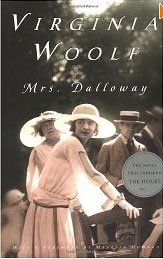Woolf, Virginia (1925). Mrs. Dalloway. Orlando, FL: Harcourt.
There is hardly anything to say about this novel that has not already been said. Considered one of Woolf’s finest, it has earned a permanent place in the canon of classics and has been analyzed to death.
Superficially, it is the story of a wealthy, fiftyish matron in 1920’s London who loves to throw fancy lunches, dinners and parties for the grandly wealthy class. We follow the inner thoughts and outer actions of Mrs. Dalloway, and her associates, over a single day as she prepares for an evening party, which is the climax of the book.
Woolf copied the stream-of-consciousness approach pioneered by Joyce (who she knew well), and I thought her version of it was more convincing than Joyce’s. Rather than have consciousness appear as a set of lengthy soliloquys, which is not how the mind goes, she portrays it as something more like waves lapping on a shore.
“But, thank you, Lucy, oh, thank you,” said Mrs Dalloway, and thank you, thank you, she went on saying (sitting down on the sofa with her dress over her knees, her scissors, her silks), thank you , thank you, she went on saying in gratitude to her servants generally for helping her to be like this, to be what she wanted, gentle, generous-hearted. Her servants liked her. And then this dress of hers – where was the tear? And now her needle to be threaded. This was a favorite dress…
The imagery of thoughts washing like waves recurs often, sometimes explicitly, and I thought it was a good one.
A second innovation was Woolf’s technique of frequent, unmarked changes in point of view, jumping from one character’s head to another, something we are warned, as modern writers, never to do. But Woolf turns the technique into a sort of impressionism that is just as effective as any painting by Monet. Sometimes the POV pivots on the striking of the hour by Big Ben. Sometimes it pivots on a curtain blowing repeatedly on a breeze. But often it is just a naked head-jump: “Mr. Bowley raised his hat and thought xyz… Suddenly Mrs. Coates looked up into the sky…” Despite this frenetic impressionism, it is to the skill of Woolf that there are only one or two spots in the entire novel where the actual POV is unclear. She manages it with such amazing skill that the reader is omniscient, even though none of the characters is. Although the narrator is omniscient, there is very little expository writing in the novel, 90% of it being conveyed by successive first-person characters.
The language tends to the lyrical, especially in portrayal of Septimus Smith’s madness, although the language itself is not poetic, because none of the characters is a poet. The diction remains on an ordinary level, but is often highly expressive because of the impressionistic streams-of-consciousness:
They (all day she had been thinking of Burton, of Peter, of Sally), they would grow old. A thing there was that mattered; a thing, wreathed about with chatter, defaced, obscured in her own life, let drop every day in corruption, lies, chatter. This he had preserved. Death was defiance.
I was less fascinated than most other reviewers seem to be, by the personalities of the characters and their relationships. They all seemed ordinary and type-cast to me, all social exterior and hollow or chaotic interiors (proven by their stream-of-consciousness expressions). None of them seemed particularly interesting or attractive. Clearly the novel is a social satire, and there are some acerbically comic descriptions. Yet the novel dwells seriously and deeply on the characters’ precious inner lives, as if they were intrinsically interesting. I found them only mildly so.
The main strength of the novel, for me, was not the story, which is virtually non-existent, and not the characters, which are only mildly interesting, but in the author’s smooth and thoughtful writing, which is worthy of emulation.

